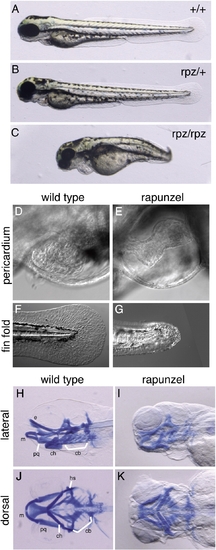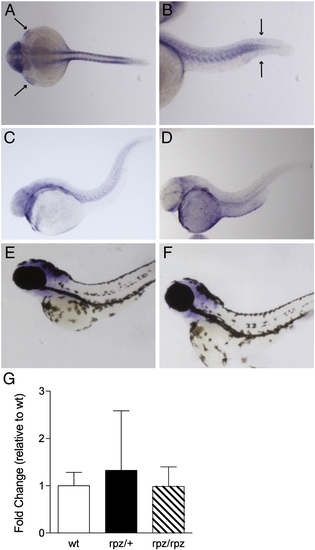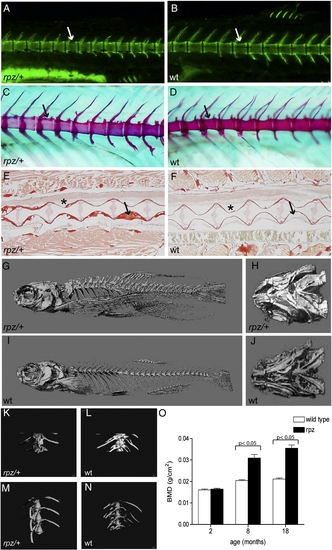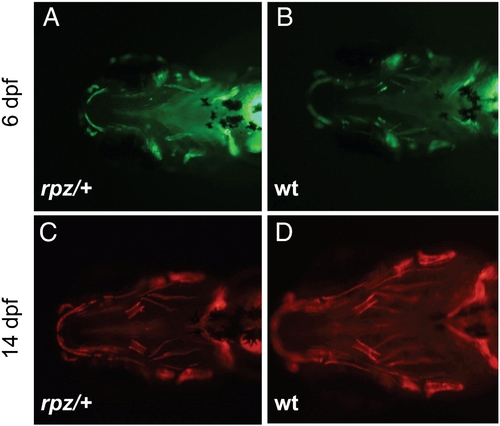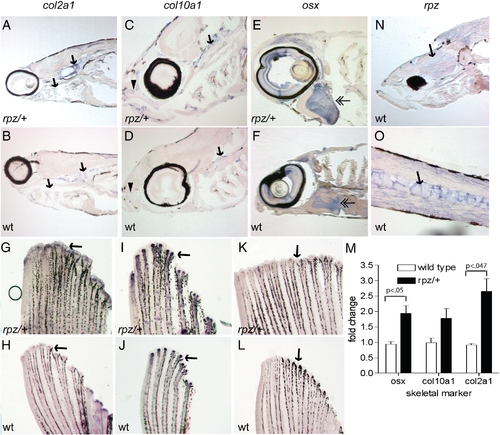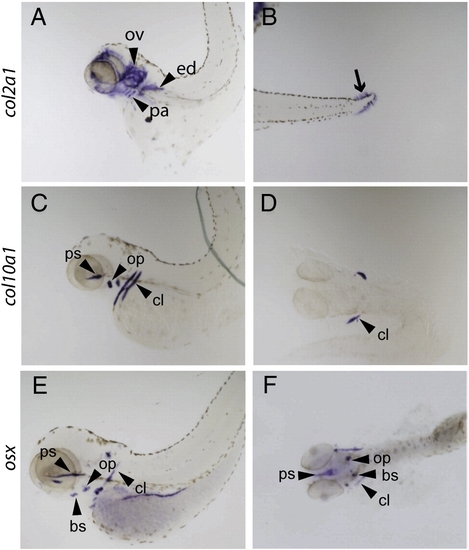- Title
-
A gain of function mutation causing skeletal overgrowth in the rapunzel mutant
- Authors
- Green, J., Taylor, J.J., Hindes, A., Johnson, S.L., and Goldsmith, M.I.
- Source
- Full text @ Dev. Biol.
|
Phenotype of rapunzel embryos. A–C. Wild type, heterozygous rapunzel and homozygous rapunzel embryos. D–G. Nomarski images of wild type (D, F) and homozygous rapunzel (E, G) embryos at 72 hpf demonstrating pericardial edema (E) and fin fold defects (G) in rapunzel mutants. H–K. Lateral (H, I) and ventral (J, K) views of whole-mount Alcian blue-stained wild type (H, J) and rapunzel (I, K) homozygous mutants at 96 hpf demonstrating reduced development of the craniofacial cartilages in rapunzel mutants. Craniofacial structures labeled as in Piotrowski et al., 1996; bh: baihyal, cb: ceratobranchial, ch: ceratohyal, e: ethmoid plate, hs: hyosymplectic, m: Meckel′s cartilage, and pq: palatoquadrate. PHENOTYPE:
|
|
Morpholino knockdown of rpz suppresses the homozygous rapunzel phenotype. Heterozygous rapunzel adult zebrafish were intercrossed and the resulting embryos injected at the 1–2 cell stage with either a morpholino targeting the start site of rpz (MOrpz) (A), a morpholino targeting rpz2 (MOrpz2) (B) or a rpz 5 base pair mismatched control morpholino (MOrpz_5bm) (C). A. Injection of MOrpz suppresses the homozygous embryonic rapunzel phenotype. The rapunzel homozygous phenotype was not suppressed in embryos injected with MOrpz2 (B) or MOrpz_5bm (C). PCR, DdeI digestion and electrophoresis confirmed that the embryos in A–C are all homozygous for the rapunzelc14 allele (not shown). PHENOTYPE:
|
|
Expression pattern and qPCR of rpz. (A) Dorsal view of an ISH for rpz in a wild type embryo at 24 hpf. Transcript is clearly seen in the somites, pectoral fin buds (small arrows) and head. (B) In a lateral view, transcript is seen in the somites and in the tail bud adjacent to the fin fold (large arrows). (C–F) Lateral views of wild type embryos at 48 hpf (C), 72 hpf (D), 80 hpf (E), and 120 hpf (F) following ISH for rpz. Expression is beginning to decrease at 48 hpf, and further still at 72 hpf, but the general distribution is unchanged from 24 hpf embryos. By 80 hpf rpz expression is localized exclusively to the head (E) and by 120 hpf expression is almost completely absent (F). (G) Quantitative RT-PCR on wild type, heterozygous and homozygous rapunzel embryos reveals no differences in rpz transcript abundance. Data are normalized to the wild type embryo. Data represent means ± SD. |
|
Adult rapunzel mutants have overgrowth and morphological changes in the axial skeleton. A, B. In two week-old larvae stained with calcein, the vertebrae of rapunzel heterozygotes (A) are less scalloped (arrows) compared to their wild type siblings (B). C, D. Similarly, alizarin red and Alcian blue staining show a loss of scalloping (arrows) in the vertebral bodies in 3 week-old heterozygous rapunzel larvae (C) in comparison to their wild type siblings (D). No skeletal hyperossification is seen at these early developmental stages (A–D). E, F. The loss of scalloping persists into adulthood (18 months old) and can be seen (asterisk) in Sirius red-stained sections from rapunzel heterozygotes (E) compared to their wild type siblings (F). Sirius red-stained sections through the vertebral column also demonstrate that rapunzel heterozygotes have increased bone deposition compared to wild type fish (arrows). G–J. MicroCT′s of 18-month-old fish demonstrate marked hyperossification in rapunzel heterozygotes compared to wild type siblings, most easily seen in the vertebral (G, I) and ventral craniofacial (H, J) skeletons. K–L. In higher power views of the mid vertebrae, hyperossification is also readily apparent in 18-month-old rapunzel heterozygotes (K) compared to wild type (L). M, N. Hyperossification is not seen in the vertebrae of 2-month-old rapunzel mutants (M) when compared to age-matched siblings (N). O. This finding is corroborated by measurements of total bone mineral density, where significant differences between rapunzel mutants and their age-matched siblings are seen at 8 and 18 months, but not at 2 months (data represent mean ± SD). PHENOTYPE:
|
|
rapunzel heterozygotes show no evidence of hyperossification during early craniofacial development. A, B. Calcein staining at 6 dpf shows a similar degree of mineralization of the craniofacial skeletons of rapunzel mutants (A) and their wild type siblings (B). C, D. Alizarin red staining at 14 dpf again shows no increased ossification of the craniofacial bones in rapunzel mutants (C) versus their wild type siblings (D). Similar results were seen at other time points between 4 and 16 dpf (not shown). |
|
Adult rapunzel mutants over express skeletal genes during early development. A–F. ISH was performed on sagittal sections from rapunzel mutants and their wild type siblings. A, B. Overexpression (arrows) of col2a1 is seen in 2-week-old rapunzel mutants (A) compared to wild type (B). C–F. Overexpression of col10a1 (C, D) and osx (E, F) is seen in the rostral (arrowheads) and caudal (arrows) craniofacial skeleton, as well as the opercle (double arrowheads) in 4-week-old rapunzel mutants (C, E) compared to wild type (D, F). G–M. Similar results are observed in the fin ray skeleton. Whole-mount ISH reveals overexpression of col2a1 (G, H), col10a1 (I, J), and osx (K, L) in rapunzel fins. These results were confirmed by qPCR (M). N, O. Whole-mount ISH reveals that rpz is diffusely expressed in the head (N, arrow) and vertebral column (O, arrow) of 4-week-old wild type larvae, but does not co-localize with skeletal markers. There were no differences in rpz expression between rapunzel heterozygotes (not shown) and wild type siblings. EXPRESSION / LABELING:
|
|
ISH for markers of cartilage (col2a1) and bone (col10a1, osx) was performed on 120 hpf heterozygous rapunzel embryos and age-matched wild type siblings. Genotype was confirmed by sequencing following ISH (not shown). No differences in expression between rapunzel mutants and their wild type siblings were observed for any of the 3 genes. A, B. col2a1 expression is seen in the pharyngeal arches (pa), otic vesicle (ov), endochondral disc (ed) and fin fold (arrow). Expression of col10a1 (C, D) and osx (E, F) is localized to the cleithrum (cl), opercle (op), parasphenoid (ps), and brachiostegal ray (bs). Similar results were seen at 48, 72, and 96 hpf (not shown). |

Unillustrated author statements PHENOTYPE:
|
Reprinted from Developmental Biology, 334(1), Green, J., Taylor, J.J., Hindes, A., Johnson, S.L., and Goldsmith, M.I., A gain of function mutation causing skeletal overgrowth in the rapunzel mutant, 224-234, Copyright (2009) with permission from Elsevier. Full text @ Dev. Biol.

